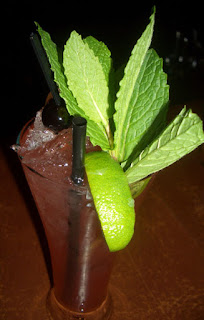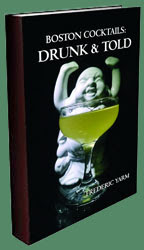In a
post a week and a half ago, I researched the effects of a cocktail glass' initial temperature on the drink that was poured into it. In that study, I shook a "Vodka Martini," strained it into room temperature, ice water-chilled, and freezer-chilled glassware, and measured how this altered the drink temperature. While unchilled glassware provided the warmest (and thus least desirable) drink, the ice water's and freezer's effect lowered the drink temperature by 1.9°F and 4.4°F, respectively, relative to the unchilled glass. While these numbers will vary by drink composition, glass size and thickness, and other variables, the end result was that the coldest drink would come from the coldest glassware. What did 2 or 4 degrees difference mean? It was like waiting 3 or 5 minutes after the drink was poured to first sip it (less time for warmer rooms). If the point of it as described by the Savoy Hotel's Harry Craddock was, "...to drink a cocktail... quickly, while it's still laughing at you," every moment or degree of chilling wasted was one too many.
In the comments section of that study, Anna of the
TwoSheetsInTheWind blog asked about the kinetics of the chilling since I took mine to extremes (glasses were put in the freezer more than 90 minutes in advance and on ice water over 20 minutes in advance). Anna inquired, "When you shorten the time the glass spends in the freezer, how does it compare? At one bar I frequent, they go through a remarkable number of glasses; on a busy night, it is not uncommon to see the dishwasher run, emptied into the freezer, and a glass from that run used within 10 or 15 minutes. What sort of effect does the freezer have versus ice water when you are looking at starting with a hot glass and can only freeze it for 15 minutes?"
When I asked a local bartender about his dish washing machine's cycle, he could not tell me when the sterilization stage fell or how hot glasses were when they came out of the washer. Instead of dealing with glasses at that moment, I started with room temperature glasses as a good starting point.
For me the question was how selecting the right glassware (stored at room temperature) for the recipe I just decided upon would effect either the spontaneity of the process or the end result. Clearly, we cannot fit all or even a significant fraction of our new and vintage glassware in our freezer (unless, of course, we got a much bigger freezer), but how much preparation would it require for ice water and freezer chilling to take its full effect on glassware? Should we be dedicating a portion of the freezer to storing a selection of glassware at all times?
To get up to speed on the other experiments, please read:
• Part 1: Effects of Glass Temperature
• Part 3: Effects of Glass Thickness on Drink Temperature
Materials:
• 2 Libbey Martini Glasses
• Freezer
• Ice from Tovolo Trays from Freezer
• Cold Water from Sink
• Digital Thermometer with Thermocouple (-58°F to 2372°F, ±0.1°F)
• Timer Application on Droid Phone
• Digital Scale
Protocol:
• Measure room temperature.
• Stick thermocouple in freezer, close door, and record the kinetics of chilling when not attached to a glass by taking temperature values every 30 seconds. Stop when temperature stabilizes to acquire freezer temperature.
• Weigh cocktail glass #1.
• Tape thermocouple inside the glass to lowest part of the cocktail glass' bowl. Wait until temperature equilibrates.

• Place glass in freezer, close door, and record temperature every 30 seconds.
• Weigh cocktail glass #2.
• Tape thermocouple to the outside of the glass to less than an inch up from the bottom of the bowl.
• Add 5 ice cubes and weigh the ice. Quickly add 3 oz cold water and weigh water.

• Record temperature every 30 seconds until temperature stabilizes.
Caveats:
• Different glass sizes and shapes will affect the end result. Here, the 2 glasses are comparable to each other, but not to other glasses.
• Variations in room temperature will affect results.
• Amount of times the freezer door is opened and closed will change the results (will happen in reality, not in this experiment though).
• Amount of air circulation in different freezers may vary and affect chilling rates; also the number of other warm glasses placed in freezer may alter the results.
• My thermometer was never calibrated.
• Experiment was only performed once per condition instead of triplicate like the last experiment.
• The thermocouple could be affected by outside air, instead of reading just the temperature of the glass. No insulation on the airside of the thermocouple was added besides tape. Hence, the glass could seem colder in the freezer and warmer at room temperature.
• Tap water was not pre-chilled with ice.
Data:
• Room temperature: 63.6°F
• Freezer temperature: >5.9°F
• Ice water temperature: 33.9°F
• Weight of glass #1 (freezer): 235.8 grams
• Weight of glass #2 (ice water): 239.2 grams
• Weight of ice: 157.3 grams (5 uncracked Tovolo cubes)
• Weight of water: 86.5 grams
• Data are single runs, not averages:

• Time for ice water glass-chilled to reach coldest point: 330-360 seconds
• Temperature of ice water-chilled glass: 38.8°F
• Difference between glass' coldest point and ice water: 4.9°F (effect of air temperature)
• Time for freezer-chilled glass to reach coldest point: over 25 minutes (>1500 seconds)
• Temperature of freezer chilled glass at end of 25 minutes: 12.5°F
• Difference between glass' coldest point and freezer: 6.6°F (effect of air temperature and incomplete cooling)
Conclusions:
In terms of spontaneity, ice water chilling was fast. At our room temperature and glass type, the full extent of the chilling occurred in 5-6 minutes. In contrast, the freezer's chilling was slow to reach its fullest effect; in fact, I tired of the experiment after 25 minutes of taking measurements ever 30 seconds. The rate of cooling was decreasing, but it was still several degrees away from its potential (at least 6.6°F, if not more due to air temperature effects on the thermocouple). Perhaps another 10 minutes or so was needed putting the range for completion at 35-45 minutes. As a positive note for spontaneity, after around 7 minutes (disregarding air temperature effects on the thermocouple), the freezer chilled glass was as cold as the ice water chilled one once it reached equilibrium. Therefore, at that time point, both techniques were equivalent in merit.
Again, the choice of glassware will effect the chilling kinetics. Moreover, while a freezer will work on the whole glass, the ice water will only work effectively on the glass' bowl and a temperature gradient will be set up in the stem. Of course, in chilling Old Fashioned glasses, the ice water would work on the whole glass including its thick base. While our Libbey glasses are not the thinnest of our collection (not the thickest either), most glasses we own are thinner which would, therefore, help to accelerate both time courses.
As the previous experiment showed, freezer-chilled glassware was the optimal choice; however, as this experiment shows, that peak of perfection is hard to do on the fly or in a high volume establishment in the weeds. The previous experiment showed that ice water chilled glassware was an intermediate choice; here, the peak of this middle ground technique was reasonably fast (under 6 minutes). At home, this would require a small amount of patience. At a high volume bar, it would require a steady line of glasses chilling in advance. Of course, the solution is to go to bars when they are less busy to have the best chance of getting cold glassware and thus cold drinks.


 2 oz Cynar
2 oz Cynar













 1 1/2 oz Greylock Gin
1 1/2 oz Greylock Gin 1 oz Brandy (Pedro Domecq Fundador Solera Reserva)
1 oz Brandy (Pedro Domecq Fundador Solera Reserva)









 The theme for this month's
The theme for this month's  Two others were the Albatross and Booby which became names of some of the mocktails that night (and the latter was the most popular mocktail of the evening and the name got partially recycled in the
Two others were the Albatross and Booby which became names of some of the mocktails that night (and the latter was the most popular mocktail of the evening and the name got partially recycled in the 






 2 oz Barbancourt Rum
2 oz Barbancourt Rum







 The 2017 collection of 855 drink recipes, bartender tributes, and essays on hospitality from CocktailVirgin's Frederic Yarm. Available at
The 2017 collection of 855 drink recipes, bartender tributes, and essays on hospitality from CocktailVirgin's Frederic Yarm. Available at  The 2012 collection of 505 drink recipes, techniques, and Boston bar recommendations from Frederic Yarm. Available at
The 2012 collection of 505 drink recipes, techniques, and Boston bar recommendations from Frederic Yarm. Available at 



